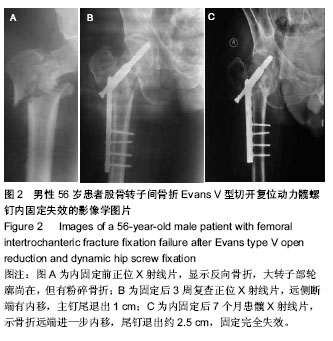| [1] Peleg E, Mosheiff R, Liebergall M, et al. A short plate compression screw with diagonal bolts-a biomechanical evaluation performed experimentally and by numerical computation.Clin Biomech (Bristol,Avon).2006;21(9): 963-968.
[2] Lin PC, Chang SY. Functional recovery among elderly people one year after hip fracture surgery.) Nurs Res.2004;12(1): 72-82.
[3] 黄公怡,文良元.转子间骨折[J].中华骨科杂志,2003,23(8):637.
[4] 张保中,邱贵兴.高龄股骨转子间骨折的手术治疗[J].中华创伤杂志, 2005,21(8):582-584.
[5] 王钢,陈凯宁,陈滨,等.动力髓螺钉在股骨转子间骨折治疗中的应用价值[J].中华创伤骨科杂志,2008,8(10):701-703.
[6] 苟三怀,王琪,刘岩,等.股骨转子间骨折的治疗方法选择(附1037例分析)[J].中华创伤骨科杂志,2007,9(4):319-322.
[7] 张经纬,蒋尧,张先龙,等.股骨转子间骨折不同手术方法比较[J]. 中华骨科杂志,2005,25(1):7-11.
[8] 张纯,贺西京,兰宾尚,等.老年不稳定性股骨粗隆间骨折动力髋治疗的疗效分析[J].中国骨伤,2005,18(4):196-197.
[9] 刘云鹏,刘沂.骨与关节损伤和疾病的诊断分类及功能评定标准[M].北京:清华大学出版社,2002.
[10] Fox KM, Magazincr J, Hebcl JR,et al. Intcrtrochantcric versusfemoral neck hip fractures; differential characteristics,treatment ,and sequclac. J Gcrontol A Biol Sci Mcd Sci. 1999;54(12):M635-640.
[11] Forster MC, Calthorpc D. Mortality following surgery for proximalfemoral fracture incentenarians. Injury. 2000;31(7): 537-539.
[12] 危杰.股骨转子间骨折[J].中华创伤骨科杂志,2004,6(5); 554-557.
[13] 贾燕飞,冯卫,佟雁翔.三种内固定方法治疗老年股骨转子间骨折的比较[J].中华创伤骨科杂志,2011,13(2):130-134.
[14] 罗从风,朱越,王磊,等.459例动力髋螺钉治疗股骨粗隆周围骨折结果分析[J].中华创伤骨科杂志,2002,4(3):188-191.
[15] 权日,徐国州,尹庆水,等.股骨转子间骨折治疗分析[J].中华创伤杂志, 2001,12(12):713-715.
[16] 徐刚,夏铿芳,杨峰,等. DHS内固定治疗股倡转子间骨折[J].中华创伤杂志,2004,6(5):581-583.
[17] 赵天云,刘新成.老年股骨转子部骨折三种不同手术方法的比较[J].中国骨与关节损伤杂志,2005,20(6):417.
[18] Haidukewych GJ,Berry DJ.Salvage of failed internal fixation of intertrochanteric hip fracture.Clin Orthop Relat Res.2003; (412): 184-188.
[19] Gotfried Y. The lateral trochanteric wall: a key element in the reconstruction of unstable pertrochanteric hip fractures.Clin Orthop Relat Res.2004;(425):82-86.
[20] 王恩时,韩本松,曾炳芳,等.股骨粗隆间骨折Gamma钉和DHS内固定治疗比较[J].中国骨与关节损伤杂志,2008,23(5):413-415.
[21] IM GI, Shin YW, Song YJ. Potentially unstable intertrochanteric fractures. J Orthop Trauma. 2005;19(1):5-9.
[22] 叶繁茂.不稳定型股骨转子间骨折的治疗[J].中国矫形外科杂志,2004,12(3):218.
[23] 郭金刚,郭金城,赵勇,等.动力骸螺钉治疗股骨粗隆间骨折并症原因分析及防治[J].中国骨伤,2008,21(5):341-342.
[24] 黄丽花,陈宗雄,郑旭锋,等.不稳定型股骨转子间骨折治疗中小转子骨折的处理[J].实用骨科杂志,2010,16(7):549.
[25] Kim JW, Oh CW, Byun YS, et al. A biomechanical analysis of locking plate fixation with minimally invasiveplate osteosynthesis in a subtrochanteric fracture model. J Trauma. 2011;70(1):E19-23.
[26] Guyton JL. Fracture of hip, acetabullum, and pelvis//Terry Cancle. Campbell’s operative orthopaedics. 9th.eds. Singapore. Harcoure Asia Mosby. 2002: 2182-2199.
[27] 蔡迎峰,陈胜,张维.股骨小粗隆缺损的生物力学评价及临床意义[J].骨与关节损伤杂志,2001,16(3):179.
[28] Laohapoonrungsee A, Arpornchayanon O, Phornputkul C. Two-hole side-plate DHS in the treatment of intertrochanteric fracture: results and complications. Injury. 2005;36 (11): 1355-1360.
[29] Baumgaertner MR, Curtin SL ,Lindskog DM, et al .The value of the tipapex distance in predicting failure of fixation of peritrochanteric fractures of the hip. J Bone Joint Surg Am. 1995;77(7):1058-1064.
[30] Baixauli F,Vicent V, Baixauli E, et al .A reinforced rigid fixation device for unstable intertrochanteric fractures.Clin O rdiop Relat Res.1999,(361):205-215.
[31] Baumgaertner MR, Solberg BD. Awareness of up-apex distance reduces failure of fixation of trochanteric fractures of the hip. J Bone Joint Surg (Br).1997;79(6):969-971.
[32] McLoughlin SW, Wheeler DL, Rider J, et al. Biomechanical evaluation of the dynamic hip screw with two-and four-hole side plates.J Orthop Trauma. 2000;14(5):318-323.
[33] 范卫民,陶松年,王道新,等.四种股骨转子间骨折内固定的生物力学对比及疗效评价[J].中华骨科杂志,1996,16(4):229.
[34] Dehne K,Curwen C,Andy W. Complex inter-trochanteric fractures in the elderly,PFN OR DHS? Injury Extra. 2007; 38(4):145-146.
[35] van Balen R,Steyerberg EW,Polder JJ,et al. Hip fracture in elderly patients:outcomes for function,quality of life,and type of residence. Clin Orthop Relat Res. 2001;(390):232-243.
[36] 沈惠良.股骨粗隆部骨折//王亦璁.骨与关节损伤[M].4版.北京:人民卫生出版社,2007:1179-1193.
[37] Curtis MJ, Jinnah RH,Wilson V,et al. Proximal femoralfracture: a biomechanical study to compare intramedullary and intramedullary fixation. Injury. 1994;25:99-104 |


.jpg)